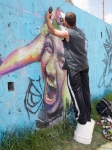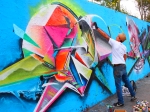Some of you have been requesting more coverage on my every day life. You want more stories of the everyday drivel and drama that may or may not relate to my research. Who on earth do I hang out with? What do I do in my free time? Have I eaten anything exciting since my last foray into exotic foods? (Short answer: yes, a large rodent).
One of the hardest things I do on this blog is try to balance a readership that consists of family and friends but also research colleagues and completely unknown followers with interest in my project. I try to balance policy writing and travelogue, sometimes resulting in hybrid hodgepodges of reflections and research as I traverse across the globe.
After my somewhat sociological rant about Inuktitut syllabics and social media, I feel I owe you some quotidiana.
The story this week is one of going from zero to sixty – an acceleration that characterizes most of my time so far as a Watson. I had no friends in Quito until all of a sudden I had many – all of them graffiti artists.
I guess it all started when I met Jamie Killen in Latacunga, an America dude just about as crazy as I am for travel, but more obsessed with Latin America. In fact, he’s working on a podcast series that covers the local and regional linguistic differences in Spanish-speaking countries. If you’re an intermediate Spanish-speaker interested in slang, local culture, linguistics, and history, you should definitely check out TellItToMeWalking.com.
And like any good Brooklyn boy, he’s way into street art.
So when he passed by Quito last week, he tuned me into an international graffiti event called The Meeting of Styles. It brought together 30 graffiti artists from Ecuador, Venezuela, Colombia, Brazil, Canada and the US and granted them a wall a day to paint to their liking. There’s a ton of informal, illegal street art in Quito, but I was excited to have all of the artists in a space where they felt comfortable discussing their art and politics. So I spent all day Sunday walking up and down a stretch of blue wall on a street in the north of Quito, marveling at what can be achieved with some pressure and paint.
I pretty much had a spiritual freak out when I saw the painting below, by the illustrious Estiven Mera of Puyo Ecuador (aka “Steep One”).
His stretch of wall portrays a polar bear swimming in ether towards a howler monkey. The artist had basically captured this phase of my life in paint: my transition from the Arctic to the jungle, the crushing simultaneity and interconnectedness of the world that conspires to keep me up at night.
I am somewhere between the bear and the monkey, I tell him, unsure if the contact will kill or save me. Extremes circle one another screaming incredulity. Jungle Rachael longs for Arctic Rachael; Arctic Rachael fades day by day or crystallizes into a distorted and romanticized form. I show him my walrus-tusk polar bear necklace from Nunavut; he talks about growing up in the jungle and how it influenced his artistic focus on the interconnectedness of species.
Felt pretty cool to reflect on my journey through this painting. I’ll learn more about Steep and his work when I go out with him for drinks this weekend.
Here’s a few more snapshots of what I saw on Sunday at the Meeting of Styles:
When strolling along, each artist inevitably asked if I was also a grafitera – graffiti artist.
“An artist of words, more or less,” I liked to reply.
But perhaps I was destined to engross myself in the world of street art a bit more, as on my way to work Tuesday morning I ran into the team of Mexican graffiti artists whom I’d chatted with the previous Sunday. We had breakfast together and they invited me to a lecture at FLACSO, the Facultad Latinoamericana de Ciencias Sociales, where they were invited to comment on the Latin American style of urban art. Between the hipster glasses and stiff desks, I felt like I was back in the world of academia – and quite at home at that.
Through this lecture, I learned about a Brazilian street artist who really captures a lot of my research questions. The work of Cranio focuses on indigenous peoples of Brazil and often the misunderstandings of native peoples within a global context [check out his Flickr for a more complete portfolio.] Yet the indigenous peoples he pictures appear almost as extraterrestrials, emphasizing their foreignness to many still even today. You’ll notice the prominent role technology and transnational corporations play in his street art depicting the indigenous; Cranio also argues, however, that we are all “natives living in a concrete jungle.” Maybe we all fancy ourselves noble/global savages. Here are some of my favorite examples of Cranio’s art, which I hope to hunt down when I head to Brazil in January:
After the lecture, I hit it off quite well with one particular Mexican grafitero, Israel aka Slep One. Slep works mostly in “WildStyle” – the iconic style that grew out of Los Angeles – but makes a living painting interiors of businesses and murals for governments and universities. He’s had an incredibly difficult life — living on the street for some time — but now focuses on the artistic passion that drives him: taking WildStyle to a new more artistic and perfect level, the politics of illegal graffiti, and educating the public on street art. He also turned me on to a cool movement in graffiti — events that bring together artists to paint stretches of cellophane. When I asked him what his favorite piece he’s painted so far is, this is what he showed me:
I always thought WildStyle was hapless, difficult to read, pointless. But hanging out with Slep has helped me understand the politics and poetics behind the movement. We talk about how much of the graffiti movement in the states is/was linked to the African-American hip-hop movement, but how Latin America has had to fill that void with other cultural influences, like in the case of Mexico, campesino discourses and the legacy of muralismo. You can check out Slep’s work on his website.
It was Slep’s first time in South America, so we spent the afternoon wandering the historical district of Quito and of course taking pictures of street art as it arose.
“Even though you’ve reach this level of international recognition, do you still do illegal graffiti?” I asked him while we sip on coffee.
“Yes, in fact, I’m planning my next one,” he said, as he pulled out a sticker of his signature and nonchalantly stuck it on one of the cafe’s pristine white mugs. I was a bit mortified, but this was nothing new to Slep. “It’s so much easier than writing your name,” he commented on the speedy yet transgressive act.
I suppose I eventually warmed up enough to the idea to play along. It was a thrill to get to know like-minded people who express their passion through a different medium. After all, what are artists, bloggers, researchers in the end but story-tellers? Who are we but people with a message and a mission, looking to transgress human disconnectedness and bring worlds crashing together with our paints, word processors, and pens?
Thanks to all of the artists for a great week.


































